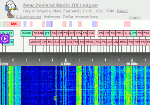THE WIRELESS WORLD.
By Magna Vox.
NEWS AND NOTES. (Part)
From the Otago Daily Times , Issue 20993, 4 April 1930, Page 5.
RADIO EXHIBITION.
The 1930 Otago Radio Exhibition, which will be held in the Early Settlers’ and Pioneers’ Halls from Tuesday, April 29, until May 2, has been planned on a considerably larger scale this year, and both of the large halls will be filled with dealers’ exhibits. More display spaces are provided than at the last exhibition, and it is with gratification that the committee is able to announce that practically all of them have been booked. Dunedin, as usual, was the first of the four centres to inaugurate radio exhibitions, and if the reports of people who attended all of them are to be relied upon Dunedin’s first effort last year eclipsed all the others, both in attendance of visitors and box office returns. Possibly as a result of these achievements the response from northern dealers desiring to book space came post haste after the prospectuses reached them, and so, when the exhibition opens, the exhibits will represent Auckland, Wellington, Christchurch, and Dunedin, and in many instances the individual displays will be larger than last year.
A very interesting exhibit will be the short wave station to be installed by the Otago branch of the New Zealand Transmitters’ Association. The public will be able to see an up-to-date plant in actual operation, and will be able to send greetings to friends in other parts of the world. The short wave station at the last exhibition created much interest, and hundreds of folk handed in greetings for transmission, most of which were acknowledged.
The Post and Telegraph Department, which is closely associated with radio in the Dominion, will have on view a very, interesting exhibit.
The Programme Committee has the entertainment section well in hand, and some high-class entertainment will be provided in the Pioneers’ Hall. These will comprise short sessions held during the afternoons and evenings, and full details of the concerts will be announced later. The opening speeches and all the concerts will be broadcast from the exhibition, arrangements for this having been completed.
Electric receivers of 1930 leave little to be desired in the matter of tonal qualities, selectivity, and beautiful cabinets, and all of the leading makes will be on view, so that the public will have an excellent opportunity of seeing and hearing the merits of each. Moreover, improved arrangements have been made this year for the catering.
The official catalogue and programme, which is now being compiled, will be obtainable from dealers some days before the exhibition opens.
A NEW STATION.
As station 4ZP, Invercargill, is amongst the most modern of the B class stations of New Zealand, listeners (and DX enthusiasts in particular) will be interested in a short description of the installation. The transmitting apparatus stands four feet high and comprises a Hartley oscillator and a Heising modulator. There are three panels. The bottom one contains the transformer, where the power is transformed from 230 volts to 1000 on each side and passed through four rectifying tubes to rectify the A.C. current to D.C. current. From the rectifying tubes it passes to the filtering and checking system, then through condensers, chokes and filters and up into the transmitting panel. From here the current goes to the oscillating and modulating tubes. The checking of the transmitter is done through four metres, the wave length meter, the aerial tuning meter, the hotwire amp. meter and the volt meter. The modulating meter requires constant watching, the check on the wave length being through this meter. The amplifying panel controls the music from the pick-up and microphone. The music is all faded in with a pick-up fader. A system of lights acts as a check on the microphone and gramophone pick-ups. There is also a clock pick-up fader for broadcasting chimes over a land line from the post office when the line is put in. Over all is a volume control. The microphones in the operating room and the studio are the latest Western electric models. The whole station is run exactly on the same system as the powerful YA stations. The wavelength used is 258 metres (1160 kilocycles), the same as that of 4ZL—Radio Record.



